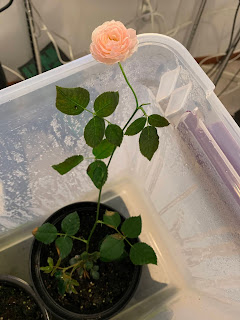 Here in the furnace of August, with the grass dry and crumbling beneath my step, my garden glows red in the hot sunshine, concentrating and sending back the searing rays towards the cloudless skies. While the garden bakes in the heat, some plants thrive and bloom, sneering back their indifference to the heat. All seem to be either red or white and today, I'll feature the red. Next week, perhaps the white. Or another week. White is always there in the garden, but seldom noticed, isn't it?
Here in the furnace of August, with the grass dry and crumbling beneath my step, my garden glows red in the hot sunshine, concentrating and sending back the searing rays towards the cloudless skies. While the garden bakes in the heat, some plants thrive and bloom, sneering back their indifference to the heat. All seem to be either red or white and today, I'll feature the red. Next week, perhaps the white. Or another week. White is always there in the garden, but seldom noticed, isn't it?
 |
| 'Centennial Spirit' |
Always
'Centennial Spirit', pictured above and at left, blooms this time of the year, a crape myrtle that returns reliably in my climate, every year nearly the brightest red in my climate. Brighter in the sunlight, as in the photo above, this particular shrub has survived two fires this year, for it lives in the
garden bed that was caught in this year's spring burn, literally rising from the ashes of April to shine brightly as always, blooming right on time. I rely on such specimens at this time of year, regular beauties to distract from the general lack of bloom when the heat soars. And 'Centennial Spirit' never disappoints me.
 |
| 'Champlain' |
I carefully wrote "nearly the brightest red" above because the Canadian rose 'Champlain' never allows itself to be outdone by a plant that only blooms in August. 'Champlain' is nearly always in bloom, a shorter shrub rose than most to be sure, but all the more prolific with its blooms despite its dwarf size. 'Champlain' is blooming its head off right now, defiant to the bleaching rays of the sun, bright red and healthy until it's petals drop. I have two 'Champlain's now, both survivors of Rose Rosette and both blooming cheerfully every day through the summer. This photo of 'Champlain' also made me realize that somewhere along the line, Apple must have improved their camera's handling of red tones. I can't ask for a better red than this from my photos.
 |
| 'Cherry Dazzle' |
Other reds are out there in the garden, less red than 'Champlain' or 'Centennial Spirit' perhaps, but red never-the-less. 'Basye's Purple rose' has had a rough couple of years, losing large canes while gaining others, but its normal deep purple blooms take on a more red tinge in the heat, the yellow stamens struggling to stand in the low humidity. And then there is another crape myrtle that draws attention from my bedroom window, the very short and red-of-another-mother 'Cherry Dazzle'. Every year, I worry that it will return from the dry sticks that mark its presence in winter, yet every summer it puffs up and blooms a more-near, slightly-pinker echo of the larger 'Centennial Spirit' down in the garden.
 |
| Basye's Purple Rose |
 |
| 'Midnight Marvel' |
I'll leave you, envious no doubt of the red fires in my garden this fall, with this closeup of
'Midnight Marvel', a bright red hibiscus with burgundy foliage that is still blooming a month after it started. The largest flower in my garden, 'Midnight Marvel' is often the size of a dinner-plate, drawing bees from acres away to feast on this stalk of pollen. And drawing my eye from across the garden, a "stop sign" planted to make me stop and admire its scarlet beauty.
 Here in the furnace of August, with the grass dry and crumbling beneath my step, my garden glows red in the hot sunshine, concentrating and sending back the searing rays towards the cloudless skies. While the garden bakes in the heat, some plants thrive and bloom, sneering back their indifference to the heat. All seem to be either red or white and today, I'll feature the red. Next week, perhaps the white. Or another week. White is always there in the garden, but seldom noticed, isn't it?
Here in the furnace of August, with the grass dry and crumbling beneath my step, my garden glows red in the hot sunshine, concentrating and sending back the searing rays towards the cloudless skies. While the garden bakes in the heat, some plants thrive and bloom, sneering back their indifference to the heat. All seem to be either red or white and today, I'll feature the red. Next week, perhaps the white. Or another week. White is always there in the garden, but seldom noticed, isn't it?













